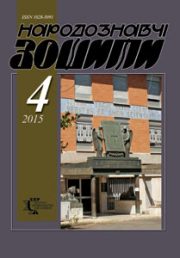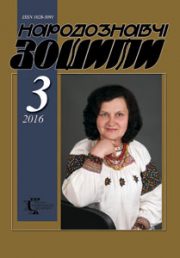The Ethnology Notebooks. 2019, № 6 (150), 1606—1619
UDK[75.046.3.071.1:27-526.62](438+477.83)”15″
DOI https://doi.org/10.15407/nz2019.06.1606
MARKOVYCH Kost’
ORCID ID: https://orcid.org/0000-0001-6915-2481
Associated proffesor of Lviv National Academy of Arts,
The department of Sacral Painting,
Merited Artist of Ukraine,
Kubiiovycha Street 38, 79011, Lviv, Ukraine
Contacts: е-mail: markostko@gmail.com
Abstract. Introduction. The iconpainting of the Western Ukraine of the 16th cent. is indicateded by the appearance of iconograthers with recognisible artistic manner, bright creative individualities. Some of them left inscriptions of their own names on executed icons, though names of the most remained unknown. This article researches the preserved heritage of an iconographer with unknown name of the first half of the 16th cent., known as an author of icons from the village of Zhohatyn (now in Poland).
Problem Statement. At the collection of NML there are four icons from the iconostasis of The Archangel Michael’s church in Zhohatyn: Christ the Teacher, Image-Not-Made-By-Hands with Border scenes and two festal icons — The Nativity of the Theotokos and The Presentation at the Temple. There are also reproductions of another two icons from the same festal row — The Descent into Hades and The Dormition of Our Lady, but the place of their reservation is actually unknown. All six works are executed by one author.
For the dating of icons from Zhohatyn the result of the dendrochronological analysis of the basis of the Christ-Teacher icon became very important. It was carried out in 2006 by Polish scientists during the process of restoration of this icon (it was completely recorded with oil paints since 1859) and defined an age of wood — 1527. This allowed M. Helytovych to date icons from Zhohatyn more specifically – by 1530th years.
There are some isolated icons from other places, which were attributed earlier to the author of icons from Zhohatyn. It is «Image-Not-Made-By-Hand», an icon of unknown origin from the collection of MNK and «Archangel Mikhael with Scenes of His Deeds» from Novoselytsia (actually Slovakia, PGM).
Results. The author of the article suggests that five more icons may be added to this artist’s work. Among them is the icon «Christ the Teacher» from of Liskovate, in which the face of the Savior bears a significant resemblance to His images on the icons from Zhohatyn. The following works are two icons «The Theotokos with Prophets and Saints» from the villages of Moschanets and Bogusha. Analogies of the author’s manner are found in the depiction of the figures on the borders. In the icon of St. Nicholas with Scenes of His Life from Lodyna the artist’s manner has been revealed in the depiction of the saint’s face and hands, as well as the decor on the ground. The last proposition is a fragmentarily saved icon of St. Yuriy The Dragonslayer of unknown origin from the collection of NMK.
Conclusion. The iconograther from the church in Zhohatyn of 1530th can be considered as author of 13 pieces of the iconpaiting of the Peremyshl eparchy of the second quarter of the 16th century.
Keywords: Iconographer, icon, 16 сentury, author of icons from Zhohatyn, festal icons, the Image-Not-Made-By-Hands, Christ the Teacher, similarity of faces of the Savior, border scenes, architectural background, dating.
Received 2.12.2019
REFERENCES
Sydor, О. (2000). Ісons of the artists Oleksiy and Dmytriy in the collection of The National Museum in Lviv. Litopys NML, 1 (6), 89—152 [in Ukrainian].
Skop, L. (2011). An author of manuscripts of The Peresopnyk Gospel — Fedusko, the iconographer from Sambir. Drohobych: Kolo [in Ukrainian].
Biskupski, R. (1982). Chosen workshops of the iconpainting of Halychyna school in XV—XVI centuries. Folia Historie Artium (Vol. XVIII, pp. 26—42). Krakуw [in Polish].
Yarema, D. (2005). The iconpainting of Western Ukraine in ХІІ—ХV сent. Lviv: Drukarski kunshty [in Ukrainian].
Yarema, D. (2017). The iconpainting of Western Ukraine in ХVI — beg. ХVІІ сent. Lviv: Drukarski kunshty [in Ukrainian].
Skop, L. (2004). An author of the icon Theotokos Hodegetria from Mraznytsya. Lviv: Logos [in Ukrainian].
Helytovych, М. (2015). An author of the icons of 1530-s from the Archangel Michael church in the village of Zohatyn. Visnyk of Lviv University: Art (Vol. 16, pp. 191—196) [in Ukrainian].
Helytovych, М. (2018). An author of icons of the 2nd half of the ХVI cent. from the Nativity of The Virgin church in the village of Liskovate on the Western Boykivshchyna. Researches of the Fine Arts, 4 64, 15—27 [in Ukrainian].
Markovych, К. (2009). The iconpainting of the artist of the middle of ХVI сent. from Lemko region, an author of the icon Theotokos Hodegetria from Uhertsi. Apologhet, 16—19, 79—86.
Markovych, К. (2009). An addition to the iconpainting works of the artist of middle of ХVI сent., an author of the icon Theotokos Hodegetria from Uhertsi. Apologhet, 20—23, 131—136. Lviv [in Ukrainian].
Helytovych, М. (2007). «The Savior Panthokrator» from Zohatyn: problems of the attribution. Litopys NML, № 5 (10), 102—106 [in Ukrainian].
Lohvyn, G., Мilyaeva, L., & Svientsitska, V. (1976). The Ukrainian medieval painting. Кyiv: Мystetsvo [in Ukrainian].
Ivanysiv, О. (1987). Church in ruin. Canada: St. Sophia Publication [in Ukrainian].
Kіosinska, J. Ikons. (1973). The National Museum in Krakow: catalogs of the collection (Vol. I) [in Polish].
Guminska, B. (2008). Gallery «Ortodox art of Old Polish Republic» (guidebook). Krakow [in Polish].
Мilyaeva, L. (with Helytovych, М.) (2007). Ukrainian icon of XI—XVIII сent. Кyiv: State collections of Ukraine [in Ukrainian].
Tkach, S. (1984). Icons From Slovakia. Warsaw; Bratislava [in Polish].
Kruk, М.Р. (2000). Icons of Theotokos with Child of the Western Ukraine of XV—XVI cent. Krakow [in Polish].
Winnitska, K. (2013). Icons of the XVI cent. in The Historical Museum in Sanok. Catalogs of the collection (Vol. II) [in Polish].
Helytovych, М. (2005). Theotokos with Child, Prophets and Saints. Lviv: Svichado [in Ukrainian].
Giemza, J. (2004). Icons of the ХV—ХVІ cent. in the collection of The Museum-Castle in w Lantsut. Art of the Western Ukraine (Vol. II, pp. 17—28) [in Polish].
Helytovych, М. (2008). Saint Nicholas with the Scenes of His Life. Lviv: Svichado [in Ukrainian].
Lohvyn, G. (1967). Painting of the ХІV—XVI сent. History of the Ukrainian art (Vol. 2). Кyiv [in Ukrainian].






